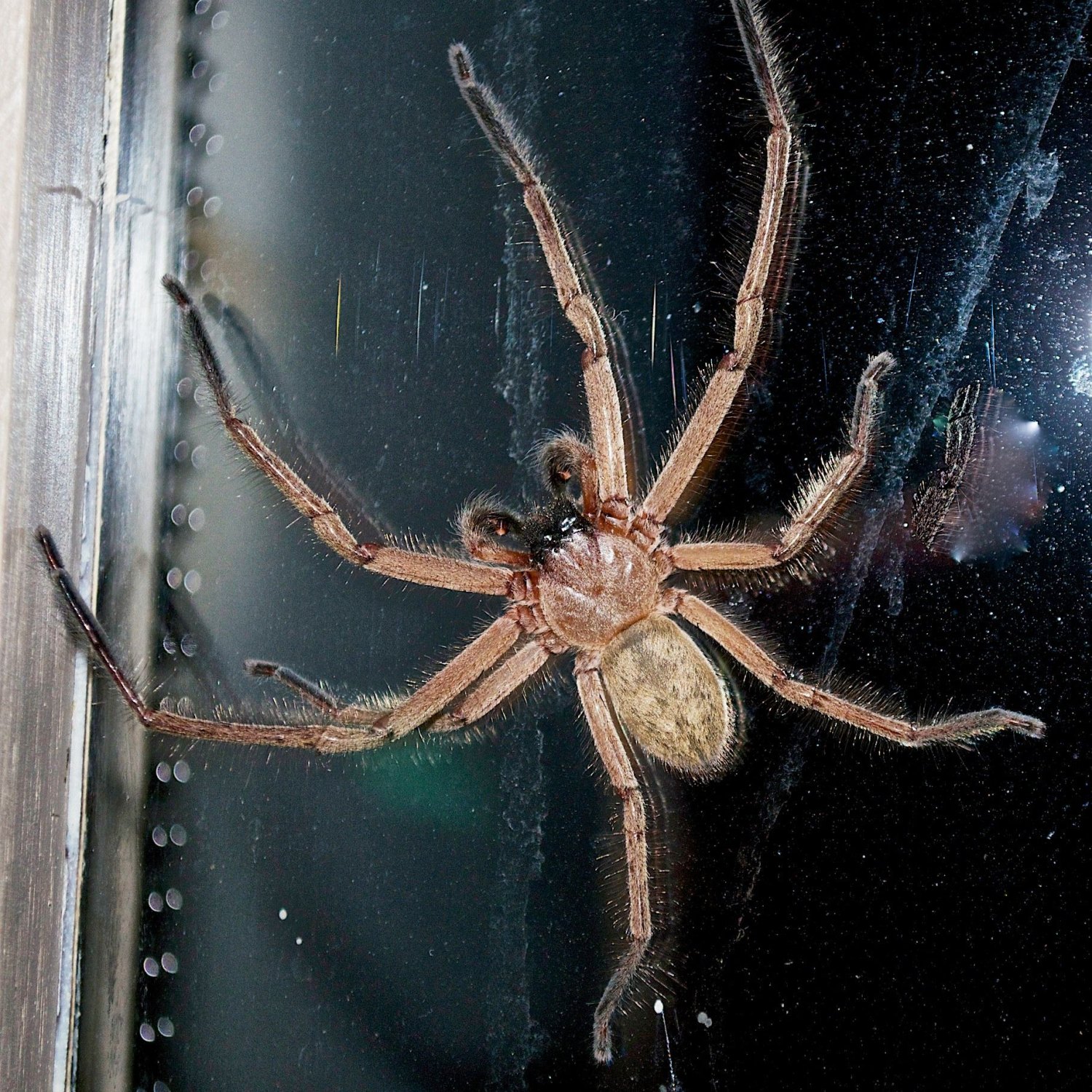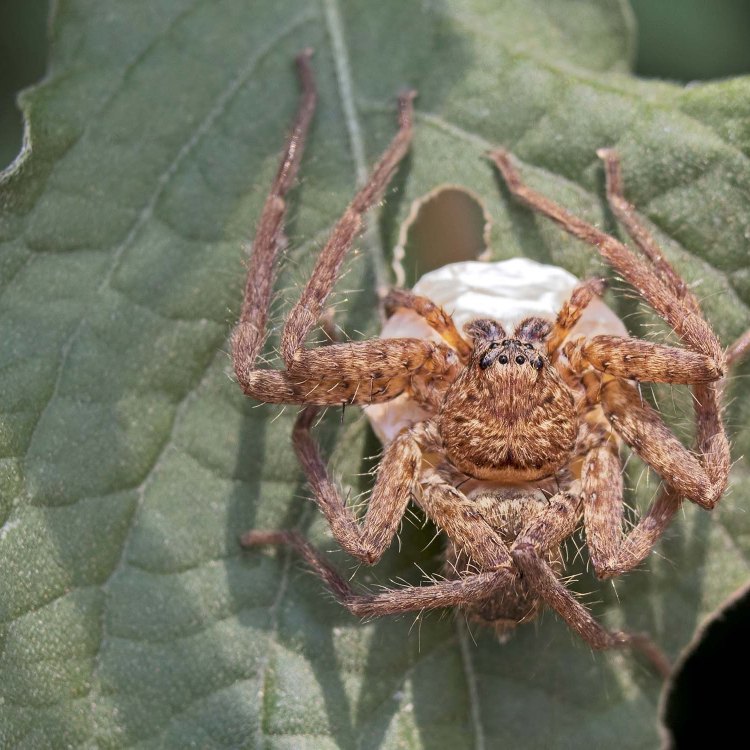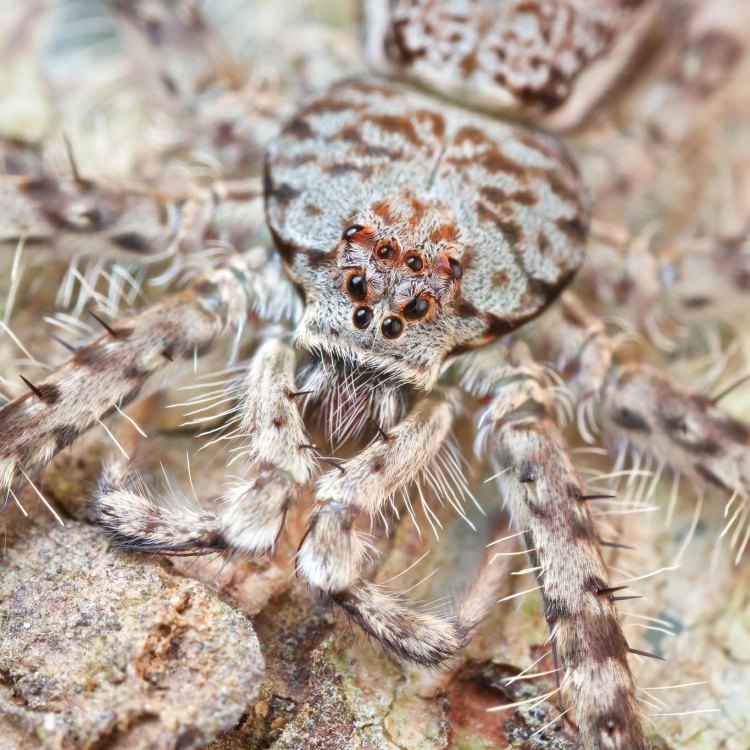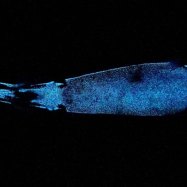
Huntsman Spider
2 to 15 centimeters
The Huntsman Spider, commonly found in various habitats, is a fascinating creature with a flattened and elongated body. Ranging from 2 to 15 centimeters in length, these spiders belong to the Sparassidae family and are known for their impressive hunting skills. Despite their intimidating appearance, Huntsman Spiders are harmless to humans and play an important role in controlling insect populations. #HuntsmanSpider #Sparassidae #NatureFacts
Animal Details Summary:
Common Name: Huntsman Spider
Kingdom: Animalia
Habitat: Tropical and temperate regions
The Fascinating World of the Huntsman Spider
Imagine walking through a dense forest or even just in your own backyard, and suddenly you spot a large spider crawling on a nearby tree. Your first instinct may be to run away, but take a closer look – it may just be a Huntsman spider! These arachnids, with their unique characteristics and abilities, have been captivating and intriguing humans for centuries. From their evolutionary adaptability to their impressive hunting techniques, the Huntsman spider is truly a remarkable creature. Let's take a closer look at this fascinating arachnid Huntsman Spider.The Scientific Name and Classification
The Huntsman spider is scientifically known as Sparassidae, which is derived from the Greek word “sparasso” meaning “to tear”. This name accurately portrays the arachnid's predatory behavior and feeding method. The Huntsman spider belongs to the Kingdom Animalia, the Phylum Arthropoda, and the Class Arachnida, placing them in the same family as spiders, scorpions, and ticks. They belong to the order Araneae and the family Sparassidae, which includes over 1000 known species of Huntsman spiders.Habitat and Geographic Distribution
The Huntsman spider can be found in a variety of habitats, from tropical rainforests to residential areas. They are known to thrive in both tropical and temperate regions, making them a common sight in many parts of the world. While their country of origin is still unknown, the Huntsman spider can be found in various habitats and ecosystems worldwide. They are most commonly found in Asia, Australia, and Africa but have also been sighted in parts of Europe and the Americas.Appearance and Body Shape
One of the most striking things about the Huntsman spider is their size and appearance Hyena. They are relatively large spiders, with some species growing up to 15 centimeters in length. Their flattened and elongated body shape makes them look even larger than they actually are. Their legs are positioned far out to the side, giving them a crab-like appearance, hence their nickname “crab spiders”. The Huntsman spider's body is covered in fine hairs, giving them a velvety appearance. They have eight eyes arranged in two rows and can have a variety of colors, including brown, gray, and black, making them well camouflaged in their surroundings.Feeding Method and Hunting Techniques
One of the most fascinating things about the Huntsman spider is their hunting technique. They are carnivores, feeding mainly on insects and other small invertebrates. However, unlike other spiders that catch and kill their prey in webs, Huntsman spiders are active hunters and do not spin webs to catch their food. Instead, they use their impressive hunting abilities and speed to catch their prey. They are known to be both ambush and chase predators. They can move swiftly, covering distances of up to one meter in a single leap, making them incredibly efficient at catching their prey.The Huntsman Spider's Adaptability
The Huntsman spider has been able to adapt and thrive in various environments due to its unique physical and behavioral characteristics. Their flattened body shape allows them to easily fit into tight spaces and hide in crevices. They also possess a strong grip, thanks to tiny spines on their feet, making them excellent climbers. This means they can easily navigate different types of terrain, from tree bark to walls and ceilings.Moreover, Huntsman spiders are also known for their incredible camouflage skills, which help them evade predators and catch their prey. Their ability to change color in response to their surroundings makes it almost impossible for their prey to spot them. This also makes them notoriously difficult to spot for humans, resulting in many “jump scares” when they suddenly appear in unexpected places.
Interactions with Humans
The presence of Huntsman spiders in residential areas often causes fear and panic among humans. However, these arachnids are not considered dangerous to humans. They are generally shy and non-aggressive and will only bite if threatened or provoked. Their venom is not fatal to humans, although their bite can be painful and cause slight swelling and redness. The Huntsman spider also plays a vital role in controlling insect populations, making them beneficial to human settlements.Conservation Status
The Huntsman spider is not considered a threatened species, and their population is generally widespread and stable. However, their habitats are under threat due to deforestation and urbanization. As predators and prey, the loss of their natural environment can have a significant impact on the Huntsman spider's population and their role in the ecosystem.In Conclusion
In conclusion, the Huntsman spider is an incredibly fascinating creature that has adapted and thrived in various environments. From their impressive hunting abilities to their unique physical characteristics, they are truly remarkable arachnids. While their presence may cause fear and panic for some, it is important to understand and appreciate their vital role in the ecosystem. So, the next time you spot a Huntsman spider, instead of running away, take a moment to observe and appreciate this incredible arachnid.

Huntsman Spider
Animal Details Huntsman Spider - Scientific Name: Sparassidae
- Category: Animals H
- Scientific Name: Sparassidae
- Common Name: Huntsman Spider
- Kingdom: Animalia
- Phylum: Arthropoda
- Class: Arachnida
- Order: Araneae
- Family: Sparassidae
- Habitat: Tropical and temperate regions
- Feeding Method: Carnivorous
- Geographical Distribution: Worldwide
- Country of Origin: Unknown
- Location: Multiple habitats
- Animal Coloration: Varies (brown, gray, black, etc.)
- Body Shape: Flattened and elongated
- Length: 2 to 15 centimeters

Huntsman Spider
- Adult Size: Varies (depending on species)
- Average Lifespan: 1 to 2 years
- Reproduction: Sexual
- Reproductive Behavior: Males perform courtship rituals
- Sound or Call: No sound production
- Migration Pattern: Non-migratory
- Social Groups: Solitary
- Behavior: Nocturnal
- Threats: Predation, habitat loss
- Conservation Status: Not evaluated
- Impact on Ecosystem: Predator control of insect populations
- Human Use: None
- Distinctive Features: Large size and long legs
- Interesting Facts: Huntsman spiders are known for their ability to crawl on walls and ceilings
- Predator: Various predators, including birds

Sparassidae
The Amazing and Mysterious World of the Huntsman Spider
When you think of a spider, what comes to mind? Creepy, eight-legged creatures that scuttle across the floor and spin webs to catch their prey, right? Well, get ready to have your perception of spiders changed, because we're about to dive into the fascinating world of the Huntsman Spider.From their impressive size and unique features to their role in the ecosystem and lack of human use, the Huntsman Spider is a mysterious and captivating creature that deserves our attention. So, let's grab our magnifying glass and explore the intriguing world of this nocturnal arachnid.
Size and Lifespan
First and foremost, let's address the elephant in the room - or rather, the giant spider on the wall PeaceOfAnimals.Com. The Huntsman Spider, also known as the Giant Crab Spider, can vary greatly in size, depending on the species. Some can have a leg span of 12 inches, making them one of the largest spider species in the world. However, most species of Huntsman Spiders are much smaller, with an average leg span of 2 to 3 inches.Despite their size, Huntsman Spiders have a relatively short lifespan of only 1 to 2 years. This may seem short, but it's actually longer than most other spider species, which typically only live for a few months. With proper care and a predator-free environment, some species of Huntsman Spiders can even live up to 5 years.
Reproduction and Courtship
Like most spiders, the Huntsman Spider reproduces sexually, meaning they require both a male and female to produce offspring. However, what sets them apart is their unique courtship rituals. Unlike many other spider species, where the male deposits his sperm on a web for the female to collect, male Huntsman Spiders actively court the female Helicoprion.Males approach the female and vibrate their legs, producing vibrations that can be felt by the female. These vibrations are crucial for courtship and are believed to play a role in the male's ability to communicate with the female. If the female is receptive, the male will continue to vibrate his legs and move closer to the female, eventually mating with her.
No Sound, But Plenty of Movement
While many animals use sound to communicate, Huntsman Spiders do not produce any sound. This may be surprising, considering their size and active reproductive behavior, but these spiders are actually very quiet creatures. They communicate with each other through vibrations and touch, making them masters of stealth and surprise.However, don't be fooled by their lack of sound - Huntsman Spiders are incredibly agile and quick-moving. Their long legs allow them to move with lightning speed, making them excellent hunters and escape artists.
Not Migratory, But Not Homebodies
Unlike other spider species, Huntsman Spiders are not migratory. Instead, they prefer to stay in one place, building their homes in crevices, tree bark, or under rocks. However, this doesn't mean they don't move around. They are known to travel up to half a mile in search of food, making them quite the explorers in their smaller territories.Huntsman Spiders also have a unique behavior when it comes to defending their territory. If threatened, they will often use their long legs to create a hissing sound, which is actually the quick rubbing of their legs together. This serves as a warning to keep predators at bay, proving that these spiders are not to be underestimated.
Solitary Creatures of the Night
The Huntsman Spider is a solitary creature, meaning they prefer to live alone rather than in groups. This may be surprising, considering their large size, but it's believed that this behavior is due to their hunting style. These spiders rely on stealth and surprise to catch their prey, which requires a solitary lifestyle.As nocturnal creatures, Huntsman Spiders are most active at night, using their excellent night vision and agility to catch insects, other spiders, and sometimes even small vertebrates. During the day, they will typically hide in their shelters, waiting for the cover of darkness to go out and hunt.
Threats and Conservation Status
Like most animals, Huntsman Spiders face various threats in their natural habitat. Their most significant threat comes from predators, including birds, lizards, and other spiders. Birds, in particular, enjoy snacking on Huntsman Spiders, thanks to their large size and slow reaction time.Habitat loss is also a concern for these spiders, as deforestation and urbanization continue to take over their natural habitats. Thankfully, the conservation status of Huntsman Spiders is not currently evaluated, meaning they are not considered endangered or threatened.
Predator Control and Human Use
While Huntsman Spiders themselves may not have a direct impact on humans, they play a vital role in their ecosystem. These spiders are natural predators, controlling insect populations in their habitats. Without them, we could see a surge in pests such as flies, cockroaches, and other creepy crawlies.Unfortunately, there is no known human use for Huntsman Spiders. Their large size and lack of venom make them difficult to exploit for any commercial or medical purposes. However, they are fascinating creatures to observe and can make for great photographic subjects (if you're brave enough to get close!).
Distinctive Features and Interesting Facts
One look at a Huntsman Spider, and you'll know why they're called "giant crab spiders." These arachnids have long, spindly legs, giving them a crab-like appearance when they move. Their large size and unique shape make them stand out among other spider species, making them an exciting creature to study.Aside from their appearance, Huntsman Spiders are also known for their ability to climb and crawl on walls and ceilings. They have special claws on their feet and a layer of super-sensitive hairs on their legs that allow them to grip onto surfaces, even upside down.
Predators of the Huntsman Spider
While Huntsman Spiders may be predators themselves, they are not immune to being hunted by other animals. As mentioned earlier, birds and lizards are their primary predators, but they also face threats from other spider species and even parasitic wasps.One predator of the Huntsman Spider that stands out is the spider-hunting wasp. The wasp will hunt down the spider and paralyze it with a venomous sting, allowing it to lay its eggs on the immobilized spider. This may sound gruesome, but it's a natural part of the ecosystem, and the wasp's offspring will eventually feed on the spider as they develop.
In Conclusion
The Huntsman Spider is a fascinating and mysterious creature that deserves our admiration and understanding. From their unique reproductive behavior and courtship rituals to their impressive size and stealthy hunting abilities, these spiders are truly a wonder of nature.While they may not have any direct impact on humans, Huntsman Spiders play a crucial role in their ecosystem, controlling insect populations and providing a food source for other animals. So, the next time you see a Huntsman Spider lurking in the shadows, don't be afraid - instead, take a moment to appreciate their incredible features and contributions to the natural world.

The Fascinating World of the Huntsman Spider
Disclaimer: The content provided is for informational purposes only. We cannot guarantee the accuracy of the information on this page 100%. All information provided here may change without prior notice.












